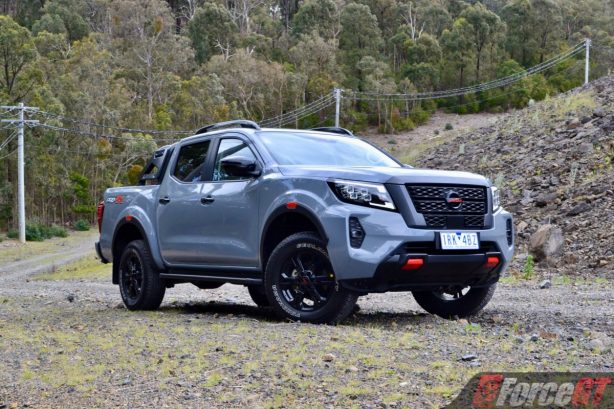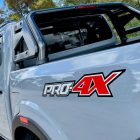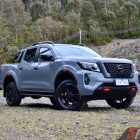The current third-generation Nissan Navara has been around in Australia since 2015, but incremental updates over the years have kept it fresh. New grades and special edition models were introduced, adjustment and refinement to the chassis were made, and safety features were boosted.
In what is quite possibly the biggest update to the Navara yet, 2021 sees the workhorse receiving range-wide styling enhancements, yet another round of chassis tweaks and stronger safety credentials.
But headlining the update is a sporty new range-topper called the PRO-4X, which now joins the simplified line-up consisting of the SL, ST and ST-X variants (the DX and RX variants are no longer offered).
If the already adventurous PRO-4X isn’t enough for you off-road junkies, there’s also the fully ruggedised PRO-4X Warrior which is designed to go head-to-head with off-road focused utes from rival makes such as the Toyota HiLux Rugged X and Mazda BT-50 Thunder.
2021 Nissan Navara Pricing
Private driveaway pricing for the 12-variant 2021 Nissan Navara range starts at $33,890 for the SL grade single cab chassis 4×2 manual, stretching to $62,790 for the PRO-4X dual cab 4×4 automatic.
The PRO-4X Warrior special edition comes in as the priciest Navara ever, with the manual version asking $67,490 and the auto fetching a $2,500 premium at $69,990. Both stickers exclude on-road costs.
We tested the ST-X dual cab 4×4 auto with cloth interior which is priced at $58,790 driveaway. Our tester has been optionally beefed up with a few genuine Nissan factory-fitted off-road goodies. They include a polished bulbar ($3,238), bonnet protector ($160), LED Light Bar ($956), winch ($2,295), winch mount kit ($852) and fender flares ($1,051).
That’s a total of $8,552 worth of accessories, bringing the final price of our tested ST-X to $67,342 driveaway (additional dealer-fitment costs may apply).
It’s worth noting that many of these accessories are fitted as standard on the PRO-4X Warrior, which in addition also comes with all terrain tyres and an off-road focused suspension complete with a wider track and an increased ground clearance.
We will be testing the PRO-4X Warrior in the new year but in this review, in addition to the ST-X we also drove the PRO-4X auto.
New Styling
Utes are fast becoming lifestyle vehicles, which means they work during the week and play on weekends. This also means agricultural looks just don’t cut it anymore. Ute buyers now appreciate good styling and the third-gen Navara has always been one of the better-looking utes.
This round of styling update gives the Navara an even more purposeful look. The front fascia is where most of the design changes have taken place. The prominent grille with its thick surrounds instantly identifies the Navara and it’s obvious the design is inspired by the Nissan Titan – the brand’s American market full-size pickup.
Sandwiching the new grille are redesigned headlights with new clusters for the daytime running lights. They are matched to a new bumper with restyled fog light bezels and skid plate.
At the rear the changes are a lot subtler, with updates limited to the tailgate, taillights and bumper. Strangely, the strip of plastic protector that lined the top of the tailgate in the previous model has now been removed. This means there’s now nothing to protect the top of the tailgate from being scratched by objects resting on it. It’s not a biggie but it seems odd that Nissan chose to delete it.
The new PRO-4X model is differentiated by matte black grille and front bumper skid plate, gloss black door handles, side mirror caps, roof racks and running boards, accented by 17-inch black wheels wrapped in Yokohama Geolander all-terrain tyres tucked under subtle black wheel arch mouldings.
The design is taken up another notch with lively red accents on the front and rear Nissan emblem, skid plate and wheel arches.
Draped in the exclusive solid grey paint work as is on our test vehicle, the PRO-4X is easily one of the most striking and sporty utes on the market today. It even turned quite a few heads everywhere we went during our weeklong test.
Interior
The interior has stayed largely the same for 2021, design wise at least, with notable changes including a new steering wheel and redesigned instrumentation panel.
Much of the update is under the skin, where extra sound deadening insulation results in a quieter cabin – not that the previous cabin was noisy by any means. Cruising on the freeway, noise level inside is very SUV-like, with not much road and engine noise at all.
Seat comfort is good for all on board, with rear passengers benefitting from upgrades to the seat cushions and back shapes. For added convenience, rear passengers in the back can also now utilise the new rear armrest with built-in cup holders to store beverages or smartphones.
All variants get an 8-inch infotainment touchscreen with Apple CarPlay and Android Auto connectivity, with ST-X grades and above also featuring satellite navigation and DAB+ digital radio.
In addition to conventional USB ports in the front and back, the updated interior has also scored a new generator USB Type C port in the centre console, which supports fast charging of devices.
Matching its black and red accented exterior, the PRO-4X cabin features a black Nissan emblem with red highlights on the steering wheel, black trim inserts in place of silver on the console and quilted black leather seats with red stitching with PRO-4X embroilment.
Disappointingly, the front seats in the PRO-4X are manually adjusted, not powered. The feature can be opted in the ST-X grade as part of an optional pack, but in the PRO-4X it’s not even available as an option.
It’s the same story with the sunroof, where it’s optional in the ST-X but not offered at all in the PRO-4X.
It’s questionable that the PRO-4X misses out on these convenient features given its range-topping status.
Oddly also, unlike the ST-X, the rear seat base in the PRO-4X cannot be lifted and folded to create extra cabin storage.
Powertrain
There were no changes under the bonnet. All 4×4 Navara variants are powered by the proven 2.3-litre intercooled twin-turbo diesel engine that outputs 140kW of power at 3,750rpm and 450Nm of torque between 1,500rpm and 2,500rpm.
It’s hooked to a seven-speed automatic transmission as fitted to both our test vehicles (or standard 6-speed manual).
Also intact in this round of update is the Navara’s part-time 4WD system. It has a dual-range transfer case that allows drivers to switch between 2WD (two-wheel drive), 4H (4WD high-range) and 4Lo (4WD low-range) drive modes via a dial in the console. The 4WD system is backed by a lockable rear differential and hill descent control.
Like before, towing capacity is rated at 3,500kg braked and 750kg unbraked.
Driving Impression
Back when it was first launched, the third-gen Navara copped quite a bit of criticism for its controversial use of coil spring rear suspension instead of the more common leaf spring set up. The idea was to give the ute a more comfortable ride, but the tub was known to sag under a heavy payload.
Over the years the rear chassis has been relentlessly tweaked and refined to a point that it’s finally right. The Navara’s SUV-like ride comfort is given, but it’s now also capable of keeping a relatively straight posture when heavy cargo is strapped to its back.
If you’re looking to use your ute as more of a lifestyle vehicle, with the occasional off road excursion, and less as an out-and-out heavy duty workhorse, you’d be more than pleased with the Navara’s all rounded performance.
While other utes suffer from jiggly ride when unladen, the Navara remains smooth. Potholes, level crossings and rough roads are far less of a battle in the Navara than in other utes.
Chuck the Navara into a bend and it continues to impress with neat handling and lots of grip. Throttle response is good for a diesel and the turning the steering isn’t like a wrestling match.
On the rough stuff, the Navara’s 4WD exhibits excellent torque distribution, ensuring good traction on a variety of terrain.
The PRO-4X’s all-terrain tyres do offer a slight advantage on slippery surfaces compared to the standard rubber on the regular models, but more heavy-duty tyres are recommended for serious off-roading.
Running Costs
In terms of running cost, the Navara doesn’t disappoint. The twin-turbo diesel is remarkably thrifty on the freeway, zipping around 6.0L/100km on test. It isn’t too shabby around town, too, hovering at around 9.0L/100km. At the end of the tests, both the ST-X and PRO-4X’s averaged around 8.5L/100km, with a mostly unladen tub and a good mix of urban and country driving. This is against a factory rated 8.1L/100km.
It has a long service interval, only requiring a visit to the dealer every 20,000km or 12 months, whichever comes first.
The warranty period is 5 years with no cap on kilometres. A complementary roadside assist of 5 years is included.
Verdict
Design & Comfort
Performance & Handling
Quality
Economy
Equipment & Features
OUR SCORE
3.9/5
+ Plus
- Rugged good looks
- All-rounded performance
- Smooth drivetrain
- Well equipped
– Minus
- Thick A pillar
- PRO-4X misses out on convenience features
Overall
Few utes in the market offer such a good combination of a workhorse and an adventure vehicle as the Nissan Navara. Continuous improvement like this recent 2021 update has seen the Navara developed into a well-rounded, lifestyle ute that is comfortable as a daily, capable at work and fun at play.
The sporty Navara PRO-4X variant is no doubt one of the sexiest looking utes around, but the premium you pay for one over a standard ST-X is more just for show than a step up in ability. For the real off-road package, the PRO-4X Warrior (launching 2022) is the one to look out for.
2021 Nissan Navara ST-X and PRO-4x Pricing and Specification
| Price (private driveaway) | From: $57,290 ST-X Dual Cab Pickup 4X4 Manual (Cloth Interior) $57,290 Dual Cab Pickup 4X4 Auto (Cloth Interior) $58,790 Dual Cab Pickup 4X4 Auto (Leather Interior6) $59,790 Dual Cab Pickup 4X4 Auto (Leather Interior6 & Sunroof) $60,790 PRO-4X Dual Cab Pickup 4X4 Manual $61,290 Dual Cab Pickup 4X4 Auto $62,790 |
| Warranty | 5 years / unlimited km |
| Warranty Customer Assistance | 5 years roadside assist |
| Country of Origin | Japan (built in Thailand) |
| Service Intervals | 12 months/20,000km |
| Engine | 2.3-litre four-cylinder common-rail direct-injection twin-turbo diesel: 140kW @ 3,750rpm, 450Nm @ 1,500-2,500rpm |
| Transmission | 6-speed manual / 7-speed automatic (tested) |
| Drivetrain | Four-wheel drive |
| Power to Weight Ratio (W/kg) | 70.1 |
| 0-100km/h (seconds): | N/A |
| Combined Fuel Consumption (L/100km) | Claimed: 8.5 / Tested: 8.3 |
| RON Rating | N/A |
| Fuel Capacity (L) | 80 |
| Body | Dual Cab Pickup, 5-seats |
| Safety | 5-star ANCAP, 7 airbags, ABS, EBD, BA, VSC, Hill Descent Control (HDC), Hill Start Assist (HSA), Active Brake Limited Slip (ABLS), 360-degree camera |
| Dimensions (L/W/H/W-B) mm | 5,255/1,850/1,855/3,150 |
| Kerb Weight (kg) | 2,142 |
| Payload (kg) | 1,024 |
| Turning circle between kerbs | 12.5 |
| Ground Clearance: | 224 / 220 (PRO-4X) |
| Wading Depth: | 600 |
| Approach Angle: | 32.7 / 32 (PRO-4X) |
| Departure Angle: | 20.3 / 19.8 (PRO-4X) |
| Breakover Angle: | 23.2 / 22.9 (PRO-4X) |
| Towing Capacity (kg): | Braked: 3,500/ Unbraked: 750 |
| Entertainment | 8.0-inch touchstreen infotainment system, satellite navigation, Bluetooth, USB, AUX, CD, AM/FM, six-speaker stereo, Apple CarPlay, Android Auto |
Competitors:
Toyota Hilux, Mitsubishi Triton, Ford Ranger, Holden Colorado, Volkswagen Amarok, Mazda BT-50, Isuzu D-Max
 ForceGT.com Car News, Car Reviews, Video Reviews, Tuning and much more.
ForceGT.com Car News, Car Reviews, Video Reviews, Tuning and much more. 


















































